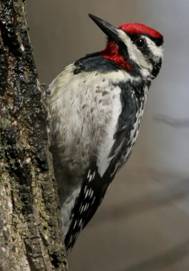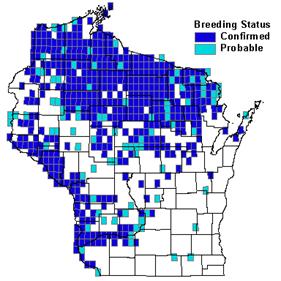Photo by Scott Franke


Status/Protection
- Global Rank: G5 Key to global and state ranks
- State Rank: S4B
- WBCI Priority: PIF
Population Information
Federal BBS information can be obtained at http://www.mbr-pwrc.usgs.gov/bbs/bbs.html by clicking on Trend Estimates and selecting the species in question. All estimates are for 1966-2005.
*Note: There are important deficiencies with these data. These results may be compromised by small sample size, low relative abundance on survey route, imprecise trends, and/or missing data. Caution should be used when evaluating this trend.
- Federal Breeding Bird Survey: non-significant increase
- Federal Breeding Bird Survey (WI): significant increase
- Federal Breeding Bird Survey (BCR 23): N/A
- Federal Breeding Bird Survey (BCR 12): significant increase*
- Chequamegon National Forest Bird Survey (NRRI): stable (1992-2005)
- WSO Checklist Project: significant increase (1983-2007)
Life History
- Breeding Range: Alaska east across Canada to the Atlantic Coast south into the Great Lakes and New England states (Walters et al. 2002).
- Breeding Habitat: Aspen, Northern Hardwood, Bottomland Hardwood, Hemlock Hardwood.
- Nest: Cavity, averages 9 meters above ground (Walters et al. 2002).
- Nesting Dates: Eggs: early May to early June (Robbins 1991).
- Foraging: Bark glean, hawks (Ehrlich et al. 1988).
- Migrant Status: Short-distance migrant, Neotropical migrant.
- Habitat use during Migration: Most forest types as well as orchards, palm groves, and scrub (Walters et al. 2002).
- Arrival Dates: Late March to mid-May (Robbins 1991).
- Departure Dates: Early September to late October (Robbins 1991).
- Winter Range: Occasionally winter in Wisconsin; most winter from the southeastern United States south through Panama with some in the West Indies (DeGraaf and Rappole 1995).
- Winter Habitat: Deciduous and mixed woodlands, bottomland forest, pine-oak forest in Mexico, some tropical forests (Walters et al. 2002).
Habitat Selection
The Yellow-bellied Sapsucker favors mature deciduous and mixed deciduous/coniferous forests (Savignac and Machtans 2006) but will nest in recent (1-5 years) selectively cut stands if mature nest trees are retained (Jobes et al. 2004). In Wisconsin, this species inhabits northern mesic forests (Hoffman 1989), northern swamps and bogs (Hoffman and Mossman 1993), boreal forest (Mossman et al. 1990), pine forests (Hoffman and Mossman 1990), and southern floodplain forests (Mossman 1988). Multiple studies have noted the association of Yellow-bellied Sapsucker and aspen. In the Cheqamegon National Forest, Yellow-bellied Sapsuckers are abundant in saw-sized quaking aspen and aspen-birch stands (Danz et al. 2007) and in western Wisconsin they frequently select nest trees surrounded by higher basal area of trembling aspen compared to the nest trees of other woodpecker species (Adkins Giese and Cuthbert 2006). Although multiple studies have noted this association between Yellow-bellied Sapsucker with aspen, it is not absolute. Yellow-bellied Sapsuckers also occur in abundance in pole-sized sugar maple stands in the Chequamegon NF and are almost exclusively associated with floodplain forests of maple, elm, cottonwood, and ash in southern Wisconsin (Mossman 1988, Danz et al. 2007). Within these southern forests, the widespread effects of Dutch elm disease and fluctuating water levels likely provides a high number of dead or dying trees suitable for nest cavities (Mossman 1988).
The Yellow-bellied Sapsucker often excavates cavities in mature live aspen, birch, maple, or beech trees with heartwood fungal infections (Savignac and Machtans 2006). Cavity trees typically are large, averaging 20 meters in height and 30-34 cm dbh (Walters et al. 2002). Although nest trees often are larger than adjacent non-nest trees (Runde and Capen 1987), large trees lacking fungal infection may be too difficult to excavate (Savignac and Machtans 2006). Paper birch is an important tree for foraging because of its sugar concentration and reliable production (Tate 1973, cited in Savignac and Machtans 2006). Sapsuckers drill shallow holes (sap wells) into a variety of woody plant species to forage for sap and often return to the same foraging sites to drill new holes above old sap wells (Walters et al. 2002, Savignac and Machtans 2006).
Habitat Availability
Yellow-bellied Sapsucker is fairly common and widespread in the northern third of the state (Robbins 1991) and along the southwestern river valleys (Temple 2006). Many of the northern forest types used by this species remain extensive across the landscape (WDNR 2005) and may be succeeding into a more favorable species composition. Forestry practices that encourage second-growth forests of aspen, white birch, sugar maple, and red maple are commonplace (WDNR 2005) and likely favor the Yellow-bellied Sapsucker. However, the suitability of these successional forests largely depends on the availability of sufficient mature cavity trees. In southwestern Wisconsin, bottomland hardwoods and other floodplain forests have fared better than many of Wisconsin’s native habitats due to the difficulty of converting them to other land uses. Nevertheless, only 8% of presettlement floodplain forest remains in moderate to high quality condition (Mossman 1988) and invasive plant species, particularly reed canary grass, and development pressures continue to threaten remaining floodplain forest tracts (WDNR 2005).
Population Concerns
Data from the Breeding Bird Survey (BBS), Chequamegon National Forest bird surveys, and Wisconsin Checklist Project indicate a positive population trend for the Yellow-bellied Sapsucker in Wisconsin (Rolley 2005, Sauer et al. 2005, Danz et al. 2007) and range-wide (Sauer et al. 2005). Robbins (1991) considered this species to be a fairly common summer resident north and uncommon central and southwest. Wisconsin Breeding Bird Atlas observers confirmed breeding in approximately 40% of the surveyed quads (Temple 2006). The loss of suitable cavity trees may be the primary factor limiting this species.
Recommended Management
Management actions that maintain and restore large tracts of structurally complex mature mesic northern forests and southern floodplain forests will benefit this species and others occurring within these landscapes, such as Red-shouldered Hawk, Least Flycatcher, Yellow-throated Vireo, and Wood Thrush. Other management recommendations for Yellow-bellied Sapsucker and other cavity-nesting species include: (1) retain all trees with nest cavities; (2) retain clumps of dead and dying trees around the nest tree; (3) retain older trees and a mix of healthy and diseased trees for nesting; (4) implement longer harvest rotations, possibly >90 years; and (5) limit herbicide use in harvest areas to allow regeneration of shrubs and saplings important for foraging.
Research Needs
Research that compares the use of nest trees before and after logging of adjacent vegetation will help determine whether management efforts should focus on nest trees or vegetation surrounding nest trees (Adkins Giese and Cuthbert 2006). Studies identifying the characteristics of quality foraging substrates also would guide management. Studies also are needed regarding the physiology of sapsuckers, dispersal, survivorship, migratory routes, and trends in populations (Walters et al. 2002).
Information Sources
- Chequamegon National Forest Bird Survey (NRRI) species account: http://www.nrri.umn.edu/mnbirds/accounts/YBSAa2.htm
- Cornell Lab of Ornithology species account: http://www.birds.cornell.edu/AllAboutBirds/BirdGuide/Yellow-bellied_Sapsucker.html
- Great Lakes Bird Conservation probability map: http://www.uwgb.edu/birds/greatlakes/species/ybsamap2.htm
- Nicolet National Forest bird survey species map: http://www.uwgb.edu/birds/nnf/species/ybsa.htm
- North American Breeding Bird Survey: http://www.mbr-pwrc.usgs.gov/bbs/bbs.html
- Wisconsin Breeding Bird Atlas http://www.uwgb.edu/birds/wbba/
References
- Askins, R. A. 2000. Restoring North America’s birds: lessons from landscape ecology. Yale Univ. Press, New Haven, CN.
- Danz, N.P., G.J. Niemi, J. Lind, and J.M. Hanowski. 2007. Birds of Western Great Lakes Forests. http://www.nrri.umn.edu/mnbirds (3 April 2007).
- DeGraaf, R.M., and J.H. Rappole. 1995. Neotropical migratory birds: natural history, distribution, and population change. Comstock Publ. Assoc., Cornell Univ. Press, Ithaca, NY.
- Ehrlich, P.R., D.S. Dobkin, and D. Wheye. 1988. The birders handbook: a field guide to the natural history of North American birds. Simon & Schuster, Inc. New York.
- Giese, C.L.A. and F.J. Cuthbert. 2003. Influence of surrounding vegetation on woodpecker nest tree selection in oak forests of the Upper Midwest, USA. Forest Ecology and Management 179: 523-534.
- Hoffman. R.M. 1989. Birds of Wisconsin northern mesic forests. Pass. Pigeon 51(1): 97-110.
- Hoffman, R.M., and M.J. Mossman, 1990. Birds of northern Wisconsin pine forests. Pass. Pigeon 52(4): 339-356.
- Hoffman, R.M., and M.J. Mossman. 1993. Birds of Wisconsin’s northern swamps and bogs. Pass. Pigeon 55(2): 113-137.
- Jobes, A.P., E. Nol, and D.R. Voigt. 2004. Effects of selection cutting on bird communities in contiguous eastern hardwood forests. Journal of Wildlife Management 68(1): 51-60.
- Mossman, M.J. 1988. Birds of southern Wisconsin floodplain forests. Pass. Pigeon 50(4): 321-337.
- Mossman, M.J., E. Epstein, and R.M. Hoffman, 1990. Birds of Wisconsin boreal forests. Pass. Pigeon 52(2): 153-168.
- Price, J., S. Droege, and A. Price. 1995. The summer atlas of North American birds. Academic Press, New York.
- Robbins, S. D. 1991. Wisconsin birdlife: population & distribution, past & present. Univ. of Wisconsin Press, Madison, WI.
- Runde, D.E. and D.E. Capen. 1987. Characteristics of northern hardwood trees used by cavity-nesting birds. J. Wildl. Manage. 51: 217-223.
- Sauer, J.R., J.E. Hines, and J. Fallon. 2005. The North American Breeding Bird Survey, Results and Analysis 1966 - 2005. Version 6.2.2006. USGS Patuxent Wildlife Research Center, Laurel, MD.
- Savignac, C. and C.S. Machtans. 2006. Habitat requirements of the Yellow-bellied Sapsucker in boreal mixedwood forests of northwestern Canada. Can. J. Zool. 84: 1230-1239.
- Tate, J. 1973. Methods and annual sequence of foraging by the sapsucker. Auk 90: 840-856.
- Temple, S.A. 2006. Yellow-bellied Sapsucker. In Atlas of the Breeding Birds of Wisconsin. (N.J. Cutright, B.R. Harriman, and R.W. Howe, eds.) The Wisconsin Society for Ornithology, Inc. 602pp.
- Walters, E.L., E.H. Miller, and P.E. Lowther. 2002. Yellow-bellied Sapsucker (Sphyrapicus varius). In The Birds of North America, No. 662 (A. Poole and F. Gill, eds.). The Birds of North America, Inc., Philadelphia, PA.
- Wisconsin Department of Natural Resources (WDNR). 2005. Wisconsin’s Strategy for Wildlife Species of Greatest Conservation Need. Madison, WI.
Contact Information
- Compiler: William P. Mueller, iltlawas@earthlink.net
- Editors: Kim Kreitinger, K.Kreitinger@gmail.com
